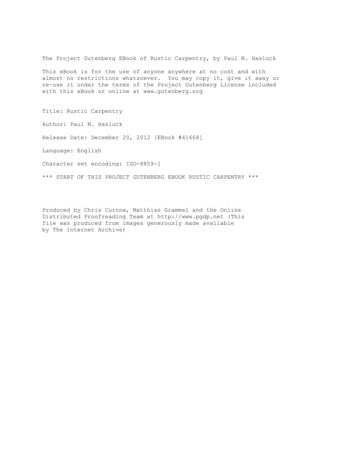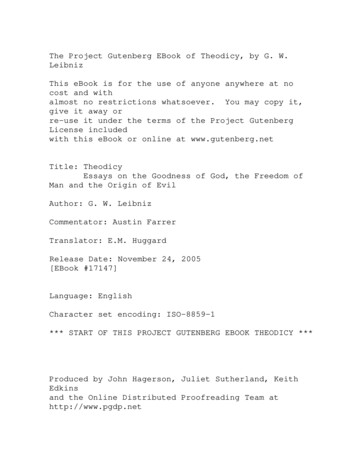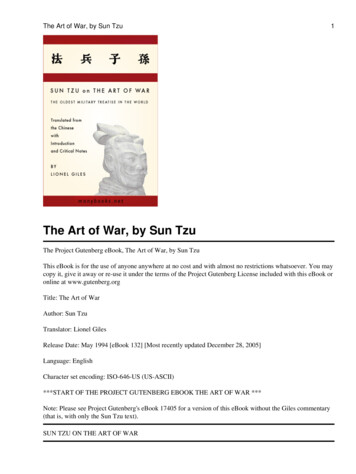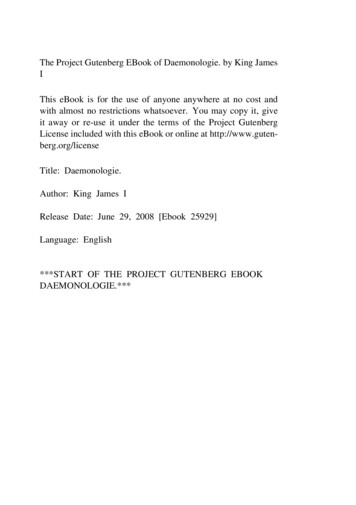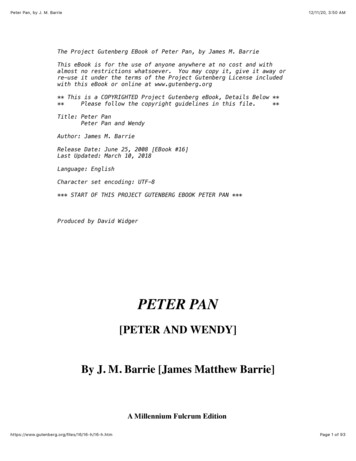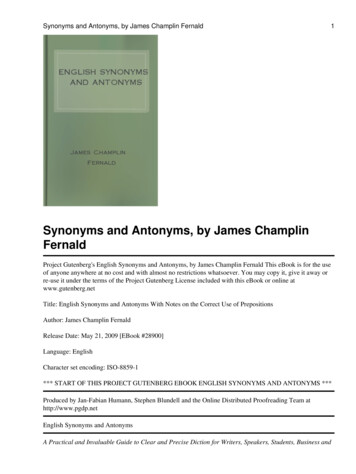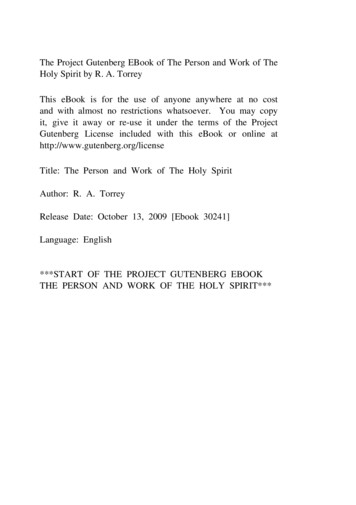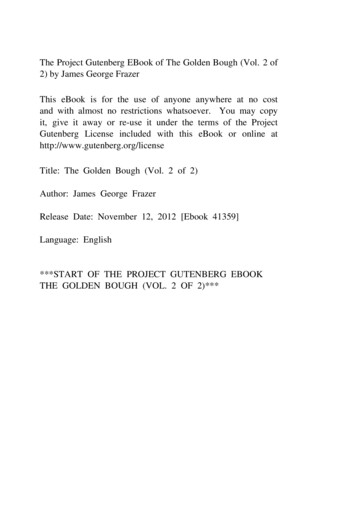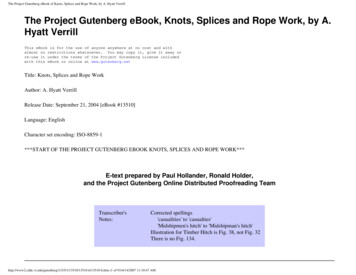
Transcription
The Project Gutenberg eBook of Knots, Splices and Rope Work, by A. Hyatt VerrillThe Project Gutenberg eBook, Knots, Splices and Rope Work, by A.Hyatt VerrillThis eBook is for the use of anyone anywhere at no cost and withalmost no restrictions whatsoever. You may copy it, give it away orre-use it under the terms of the Project Gutenberg License includedwith this eBook or online at www.gutenberg.netTitle: Knots, Splices and Rope WorkAuthor: A. Hyatt VerrillRelease Date: September 21, 2004 [eBook #13510]Language: EnglishCharacter set encoding: ISO-8859-1***START OF THE PROJECT GUTENBERG EBOOK KNOTS, SPLICES AND ROPE WORK***E-text prepared by Paul Hollander, Ronald Holder,and the Project Gutenberg Online Distributed Proofreading TeamTranscriber'sNotes:Corrected spellings'casualities' to 'casualties''Midshipmen's hitch' to 'Midshipman's hitch'Illustration for Timber Hitch is Fig. 38, not Fig. 32There is no Fig. 0/13510-h/13510-h.htm (1 of 93)4/14/2007 11:10:47 AM
The Project Gutenberg eBook of Knots, Splices and Rope Work, by A. Hyatt 3510/13510-h/13510-h.htm (2 of 93)4/14/2007 11:10:47 AM
The Project Gutenberg eBook of Knots, Splices and Rope Work, by A. Hyatt VerrillKNOTS, SPLICES and ROPE WORKA PRACTICAL TREATISEGiving Complete and Simple Directions for Making All the Most Useful and Ornamental Knots in Common Use, with Chapters on Splicing,Pointing, Seizing, Serving, etc. Adapted for the Use of Travellers, Campers, Yachtsmen, Boy Scouts, and All Others Having to Use or HandleRopes for Any Purpose.ByA. HYATT VERRILLEditor Popular Science Dept., "American Boy 1/13510/13510-h/13510-h.htm (3 of 93)4/14/2007 11:10:47 AM
The Project Gutenberg eBook of Knots, Splices and Rope Work, by A. Hyatt VerrillSECOND REVISED EDITIONIllustrated with 156 Original Cuts Showing HowEach Knot, Tie or Splice is Formed and ItsAppearance When Complete.CONTENTSINTRODUCTIONCHAPTER ICORDAGEKinds of Rope. Construction of Rope. Strength of Ropes. Weight of Ropes. Material Used in Making Ropes.CHAPTER IISIMPLE KNOTS AND 10/13510-h/13510-h.htm (4 of 93)4/14/2007 11:10:47 AM
The Project Gutenberg eBook of Knots, Splices and Rope Work, by A. Hyatt VerrillParts of Rope. Whipping and Seizing Rope. Loops. Cuckolds' Necks. Clinches. Overhand and Figure-eight Knots. Square and Reef Knots.Granny Knots. Open-hand and Fishermen's Knots. Ordinary Knots and Weavers' Knots. Garrick Bends and Hawser Hitches. Half-hitches.CHAPTER IIITIES AND HITCHESLarks' Heads. Slippery and Half-hitches. Clove Hitches. Gunners' Knots and Timber Hitches. Twists, Catspaws, and Blackwall Hitches. ChainHitch. Rolling and Magnus Hitches. Studding-sail and Gaff-topsail Halyard Bends. Roband and Fisherman's Hitches.CHAPTER IVNOOSES, LOOPS, AND MOORING KNOTSWaterman's Knot. Larks' Heads with Nooses. Cleat and Wharf Ties. Bow-line Knots. Loops and Loop Knots.CHAPTER VSHORTENINGS, GROMMETS, AND SELVAGEESTwo-, Three-, and Fivefold Shortenings. Single Plaits and Monkey Chain. Twist Braids and Braiding Leather. Open Chains. Seized and BowShortenings. Sheepshanks and Dogshanks. Grommets. Selvagee Straps and Selvagee Boards. Flemish and Artificial Eyes. Throat Seizings.Lashed Splices.CHAPTER VILASHINGS, SEIZINGS, SPLICES, ETC.Wedding Knots and Rose Lashings. Deadeye and Loop Lashings. Belaying-pin Splice. Necklace Ties. Close Bands and End Pointing. EndingRopes. Short Splices. Long Splices. Eye and Cut 13510/13510-h/13510-h.htm (5 of 93)4/14/2007 11:10:47 AM
The Project Gutenberg eBook of Knots, Splices and Rope Work, by A. Hyatt VerrillCHAPTER VIIFANCY KNOTS AND ROPE WORKSingle Crown Knots. Tucked Crowns. Single Wall Knots. Common and French Shroud Knots. Double Crown and Double Wall Knots.Crowning Wall Knots. Double Wall and Crown. Manrope Knots. Topsail-halyard Toggles. Matthew Walker and Stopper Knots. Turks' Headsand Turks' Caps. Worming, Parcelling, and Serving. Serving Mallet. Half-hitch Work. Four-strand and Crown Braids. Rope Buckles andSwivels. Slinging Casks and Barrels. Rope Belting.INDEXINTRODUCTIONThe history of ropes and knots is so dim and ancient that really little is known of their origin. That earliest man used cordage of some kind andby his ingenuity succeeded in tying the material together, is indisputable, for the most ancient carvings and decorations of prehistoric manshow knots in several forms. Doubtless the trailing vines and plants first suggested ropes to human beings; and it is quite probable that thesesame vines, in their various twistings and twinings, gave man his first idea of knots.Since the earliest times knots have been everywhere interwoven with human affairs; jugglers have used them in their tricks; they have becomealmost a part of many occupations and trades, while in song and story they have become the symbol of steadfastness and strength.Few realize the importance that knots and cordage have played in the world's history, but if it had not been for these simple and every-daythings, which as a rule are given far too little consideration, the human race could never have developed beyond savages. Indeed, I am not surebut it would be safe to state that the real difference between civilized and savage man consists largely in the knowledge of knots and ropework. No cloth could be woven, no net or seine knitted, no bow strung and no craft sailed on lake or sea without numerous knots and properlines or ropes; and Columbus himself would have been far more handicapped without knots than without a compass.History abounds with mention of knots, and in the eighth book of "Odyssey" Ulysses is represented as securing various articles of raiment by arope fastened in a "knot closed with Circean art"; and as further proof of the prominence the ancients gave to knots the famous Gordian Knotmay be mentioned. Probably no one will ever learn just how this fabulous knot was tied, and like many modern knots it was doubtless /13510-h/13510-h.htm (6 of 93)4/14/2007 11:10:47 AM
The Project Gutenberg eBook of Knots, Splices and Rope Work, by A. Hyatt Verrilleasier for Alexander to cut it than to untie it.The old sorcerers used knots in various ways, and the witches of Lapland sold sailors so-called "Wind Knots," which were untied by thesailors when they desired a particular wind. Even modern conjurors and wizards use knots extensively in their exhibitions and upon theaccuracy and manner in which their knots are tied depends the success of their tricks.In heraldry many knots have been used as symbols and badges and many old Coats of Arms bear intricate and handsome knots, or entwinedropes, emblazoned upon them.As to the utility of knots and rope work there can be no question. A little knowledge of knots has saved many a life in storm and wreck, and ifevery one knew how to quickly and securely tie a knot there would be far fewer casualties in hotel and similar fires. In a thousand ways andtimes a knowledge of rope and knots is useful and many times necessary. Many an accident has occurred through a knot or splice beingimproperly formed, and even in tying an ordinary bundle or "roping" a trunk or box few people tie a knot that is secure and yet readily undoneand quickly made. In a life of travel and adventure in out-of-the-way places, in yachting or boating, in hunting or fishing, and even inmotoring, to command a number of good knots and splices is to make life safer, easier, and more enjoyable, aside from the real pleasure onemay find in learning the interesting art of knot-tying.Through countless ages the various forms of knots and fastenings for rope, cable, or cord have been developed; the best kinds being steadilyimproved and handed down from generation to generation, while the poor or inferior fastenings have been discarded by those whose callingsrequired the use of cordage.Gradually, too, each profession or trade has adopted the knots best suited to its requirements, and thus we find the Sailor's Knot; the Weaver'sKnot; Fishermen's knots; Builders' knots; Butchers' knots; and many others which have taken their names from the use to which they areespecially adapted.In addition to these useful knots, there are many kinds of ornamental or fancy knots used in ornamenting the ends of ropes, decorating shroudsof vessels, railings, and similar objects; while certain braids or plaits, formed by a series of knots, are widely used aboard ship and on land.In many cases ropes or cable must be joined in such a way that they present a smooth and even surface and for such purposes splices are used,while knots used merely as temporary fastenings and which must be readily and quickly tied and untied are commonly known as "bends" or"hitches." Oddly enough, it is far easier to tie a poor knot than a good one, and in ninety-nine cases out of a hundred the tyro, when attemptingto join two ropes together, will tie either a "slippery" or a "jamming" knot and will seldom succeed in making a recognized and "ship-shape"knot of any sort.The number of knots, ties, bends, hitches, splices, and shortenings in use is almost unlimited and they are most confusing and bewildering tothe uninitiated. The most useful and ornamental, as well as the most reliable, are comparatively few in number, and in reality each knot learnedleads readily to another; in the following pages I have endeavored to describe them in such a manner that their construction may be 3510/13510-h/13510-h.htm (7 of 93)4/14/2007 11:10:47 AM
The Project Gutenberg eBook of Knots, Splices and Rope Work, by A. Hyatt Verrillunderstood and mastered.THE AUTHOR.JANUARY, 1917.CHAPTER ICORDAGEBefore taking up the matter of knots and splices in detail it may be well to give attention to cordage in general. Cordage, in its broadest sense,includes all forms and kinds of rope, string, twine, cable, etc., formed of braided or twisted strands.In making a rope or line the fibres (A, Fig.1) of hemp, jute, cotton, or other materialare loosely twisted together to form what istechnically known as a "yarn" (B, Fig. 1).When two or more yarns are twistedtogether they form a "strand" (C, Fig. 1).Three or more strands form a rope (D, Fig.1), and three ropes form a cable (E, Fig. 1).To form a strand the yarns are twistedtogether in the opposite direction from thatin which the original fibres were twisted; toform a rope the strands are twisted in theopposite direction from the yarns of thestrands, and to form a cable each rope istwisted opposite from the twist of thestrands. In this way the natural tendency /13510-h/13510-h.htm (8 of 93)4/14/2007 11:10:47 AM
The Project Gutenberg eBook of Knots, Splices and Rope Work, by A. Hyatt Verrilleach yarn, strand, or rope to untwist servesto bind or hold the whole firmly together(Fig. 1).Rope is usually three-stranded and the strands turn from left to right or "with the sun," whilecable is left-handed or twisted "against the sun" (E, Fig. 1). Certain ropes, such as "bolt-rope"and most cables, are laid around a "core" (F, Fig. 2) or central strand and in many cases are fourstranded (Fig. 2).The strength of a rope depends largely upon the strength and length of the fibres from which it ismade, but the amount each yarn and strand is twisted, as well as the method used in bleaching orpreparing the fibres, has much to do with the strength of the finished line.Roughly, the strength of ropes may be calculated by multiplying the circumference of the ropein inches by itself and the fifth part of the product will be the number of tons the rope willsustain. For example, if the rope is 5 inches in circumference, 5 X 5 25, one-fifth of which is5, the number of tons that can safely be carried on a 5-inch rope. To ascertain the weight ofordinary "right hand" rope, multiply the circumference in inches by itself and multiply, the resultby the length of rope in fathoms and divide the product by 3.75. For example, to find the weightof a 5-inch rope, 50 fathoms in length: 5 X 5 25; 25 x 50 1,250; 1,250 3.75 333-1/3 lbs.These figures apply to Manila or hemp rope, which is the kind commonly used, but jute, sisalflax, grass, and silk are also used considerably. Cotton rope is seldom used save for small handlines, clothes-lines, twine, etc., while wire rope is largely used nowadays for rigging vessels,derricks, winches, etc., but as splicing wire rope is different from the method employed in fibrerope, and as knots have no place in wire rigging, we will not consider it.CHAPTER IISIMPLE KNOTS AND 10/13510-h/13510-h.htm (9 of 93)4/14/2007 11:10:47 AM
The Project Gutenberg eBook of Knots, Splices and Rope Work, by A. Hyatt VerrillFor convenience in handling rope and learning thevarious knots, ties, and bends, we use the terms"standing part," "bight," and "end" (Fig. 3). TheStanding Part is the principal portion or longest partof the rope; the Bight is the part curved or bent whileworking or handling; while the End is that part usedin forming the knot or hitch. Before commencingwork the loose ends or strands of a rope should be"whipped" or "seized" to prevent the rope fromunravelling; and although an expert can readily tiealmost any knot, make a splice, or in fact do prettynearly anything with a loose-ended rope, yet it is awise plan to invariably whip the end of every rope,cable, or hawser to be handled, while a marline-spike, fid, or pointed stick will also prove of great help in working rope.To whip or seize a rope-end, take a piece of twine or stringand lay it on the rope an inch or two from the end, pass thetwine several times around the rope, keeping the ends of thetwine under the first few turns to hold it in place; then makea large loop with the free end of twine; bring it back to therope and continue winding for three or four turns aroundboth rope and end of twine; and then finish by drawing theloop tight by pulling on the free end (Fig. /13510-h/13510-h.htm (10 of 93)4/14/2007 11:10:47 AM
The Project Gutenberg eBook of Knots, Splices and Rope Work, by A. Hyatt VerrillAll knots are begun by "loops" or rings commonlyknown to mariners as "Cuckolds' Necks" (Fig. 5).These may be either overhand or underhand, and when a seizing orfastening of twine is placed around the two parts where they cross a usefulrope ring known as a "clinch" is formed (Fig. 6).If the loose end of the rope is passed over thestanding part and through the "cuckold's-neck," thesimplest of all knots, known as the "OverhandKnot," is made (Fig. 7). This drawn tight appears asin Fig. 8, and while so simple this knot 13510-h/13510-h.htm (11 of 93)4/14/2007 11:10:47 AM
The Project Gutenberg eBook of Knots, Splices and Rope Work, by A. Hyatt Verrillimportant, as it is frequently used in fastening theends of yarns and strands in splicing, whipping, andseizing.The "Figure-Eight Knot" is almost as simple as theoverhand and is plainly shown in Figs. 9 and 10.Only a step beyond the figure-eight andthe overhand knots are the "Square" and"Reefing" knots (Figs. 11 and 12). Thesquare knot is probably the most usefuland widely used of any common knot andis the best all-around knot known. It isvery strong, never slips or becomesjammed, and is readily untied. To make asquare knot, take the ends of the rope andpass the left end over and under the rightend, then the right over and under the left.If you once learn the simple formula of "Left over,""Right over," you will never make a mistake andform the despised "Granny," a most useless,bothersome, and deceptive makeshift for anypurpose (Fig. 13). The true "Reef Knot" is 510/13510-h/13510-h.htm (12 of 93)4/14/2007 11:10:47 AM
The Project Gutenberg eBook of Knots, Splices and Rope Work, by A. Hyatt Verrillthe square knot with the bight of the left or right endused instead of the end itself. This enables the knotto be "cast off" more readily than the regular squareknot (A, Fig. 12).Neither square nor reef knots, however, are reliable when tying two ropes ofunequal size together, for under such conditions they will frequently slip andappear as in Fig. 14, and sooner or later will pull apart.To prevent this the ends may be tied or seized asshown in Fig. 15.A better way to join two ropes ofunequal diameter is to use the "Openhand Knot." This knot is shown 13510-h/13510-h.htm (13 of 93)4/14/2007 11:10:47 AM
The Project Gutenberg eBook of Knots, Splices and Rope Work, by A. Hyatt VerrillFig. 16, and is very quickly and easilymade; it never slips or gives, but israther large and clumsy, and if toogreat a strain is put on the rope it ismore likely to break at the knot thanat any other spot.The "Fisherman's Knot," shown in Fig. 17, is a goodknot and is formed by two simple overhand knotsslipped over each rope, and when drawn tautappears as in Fig. 18.This is an important and valuable knot for anglers, as thetwo lines may be drawn apart by taking hold of the ends, A,B, and a third line for a sinker, or extra hook, may beinserted between them. In joining gut lines the knot shouldbe left slightly open and the space between wrapped withsilk. This is probably the strongest known method offastening fine 510/13510-h/13510-h.htm (14 of 93)4/14/2007 11:10:47 AM
The Project Gutenberg eBook of Knots, Splices and Rope Work, by A. Hyatt VerrillThe "Ordinary Knot," for fastening heavy ropes, is shownin Fig. 19.It is made by forming a simple knot and then interlacing theother rope or "following around," as shown in Fig. 20. Thisknot is very strong, will not slip, is easy to make, and doesnot strain the fibres of the rope. Moreover, ropes joined withthis knot will pay out, or hang, in a straight line.By whipping the ends to the standing parts it becomes a neat andhandsome knot (Fig. 0/13510-h/13510-h.htm (15 of 93)4/14/2007 11:10:47 AM
The Project Gutenberg eBook of Knots, Splices and Rope Work, by A. Hyatt VerrillThe "Weaver's Knot" (Fig. 22) is more useful in joining small lines, ortwine, than for rope, and for thread it is without doubt the best knotknown.The ends are crossed as in Fig. 23. The end A is then loopedback over the end B, and the end B is slipped through loop Cand drawn tight.Another useful and handsome knot is illustrated inFig. 24. This is a variation of the figure-eight knot,already described, and is used where there is toomuch rope, or where a simple knot is desired toprevent the rope running through an eye, ring, ortackle-block.It is made by forming a regular figure 10/13510-h/13510-h.htm (16 of 93)4/14/2007 11:10:48 AM
The Project Gutenberg eBook of Knots, Splices and Rope Work, by A. Hyatt Verrilland then "following round" with the otherrope as in Fig. 25. It is then drawn taut andthe ends seized to the standing part if desired.Sometimes we have occasion to join two heavy orstiff ropes or hawsers, and for this purpose the"Garrick Bend" (Fig. 26) is preeminently the best ofall knots. To make this knot, form a bight by layingthe end of a rope on top of and across the standingpart.Next take the end of the other rope and pass itthrough this bight, first down, then up, over thecross and down through the bight again, so that itcomes out on the opposite side from the other end,thus bringing one end on top and the other below, asillustrated in Fig. 27. If the lines are very stiff orheavy the knot may be secured by seizing the endsto the standing 510/13510-h/13510-h.htm (17 of 93)4/14/2007 11:10:48 AM
The Project Gutenberg eBook of Knots, Splices and Rope Work, by A. Hyatt VerrillA much simpler and a far poorer knot is sometimesused in fastening two heavy ropes together. This is asimple hitch within a loop, as illustrated in Fig. 28,but while it has the advantage of being quickly andeasily tied it is so inferior to the Garrick bend that Iadvise all to adopt the latter in its place.When two heavy lines are to befastened for any considerable time, agood method is to use the "Half-hitchand Seizing," shown in Fig. 29. This isa secure and easy method of fasteningropes together and it allows the rope tobe handled more easily, and to passaround a winch or to be coiled muchmore readily, than when other knots are used.CHAPTER IIITIES AND HITCHESAll the knots I have so far described are used mainly for fastening the two ends of a rope, or of two ropes, together. Of quite a different 10/13510-h/13510-h.htm (18 of 93)4/14/2007 11:10:48 AM
The Project Gutenberg eBook of Knots, Splices and Rope Work, by A. Hyatt Verrillare the knots used in making a rope fast to a stationary or solid object, and are known as "hitches" or "ties."One of the easiest of this class to make and one which is very useful in fastening a boator other object where it may be necessary to release it quickly is the "Lark'sHead" (Fig. 30). To make this tie, pass a bight of your rope through the ring, or otherobject, to which you are making fast and then pass a marline-spike, a billet of wood, orany similar object through the sides of the bight and under or behind the standing part,as shown in A, Fig. /13510-h/13510-h.htm (19 of 93)4/14/2007 11:10:48 AM
The Project Gutenberg eBook of Knots, Splices and Rope Work, by A. Hyatt VerrillThe end of the rope may then be laid over and under the standing part and back over itself.This knot may be instantly released by merely pulling out the toggle.Almost as quickly made and unfastened is the "Slippery Hitch" (Fig. 0/13510-h/13510-h.htm (20 of 93)4/14/2007 11:10:48 AM
The Project Gutenberg eBook of Knots, Splices and Rope Work, by A. Hyatt VerrillTo make this, run the end of the rope through the ring or eye to which it is beingfastened, then back over the standing part and pull a loop, or bight, back through the"cuckold's neck" thus formed (Fig. 33). To untie, merely pull on the free end.Two half-hitches, either around a post or timberor around the standing part of the rope, make anideal and quickly tied fastening (Figs. 34 and35). To make these, pass the end around thepost, ring, or other object, then over and aroundthe standing part between the post and itself,then under and around the standing part /13510-h/13510-h.htm (21 of 93)4/14/2007 11:10:48 AM
The Project Gutenberg eBook of Knots, Splices and Rope Work, by A. Hyatt Verrillbetween its own loop and the first one formed.After a little practice you can tie this knotalmost instantly and by merely throwing acouple of turns around a post, two half-hitchesmay be formed instantly. This knot will holdforever without loosening, and even on asmooth, round stick or spar it will stand anenormous strain without slipping.A more secure knot for this same purpose is the "Clove Hitch" (Fig. 36),sometimes known as the "Builders' Hitch."To make this, pass the end of rope around the spar ortimber, then over itself; over and around the spar, andpass the end under itself and between rope and spar, asshown in the /5/1/13510/13510-h/13510-h.htm (22 of 93)4/14/2007 11:10:48 AM
The Project Gutenberg eBook of Knots, Splices and Rope Work, by A. Hyatt VerrillThe Clove hitch with ends knotted becomes the "Gunners' Knot" (Fig. 37).These are among the most valuable and important of knots and are useful ina thousand and one places. The Clove hitch will hold fast on a smoothtimber and is used extensively by builders for fastening the stageing to theupright posts. It is also useful in making a tow-line fast to a wet spar, ortimber, and even on a slimy and slippery spile it will seldom slip.For this purpose the "Timber Hitch" (Fig. 38) is even better than the Clove hitch. Itis easily made by passing the end of a rope around the spar or log, round thestanding part of the rope and then twist it three or more times around, under and /1/13510/13510-h/13510-h.htm (23 of 93)4/14/2007 11:10:48 AM
The Project Gutenberg eBook of Knots, Splices and Rope Work, by A. Hyatt VerrillIf you wish this still more secure, a single half-hitch may betaken with the line a couple of feet further along the spar (Fig.39).It is remarkable what power to grip a twisted rope has, and the "Twist Knots" shownin Figs. 40 and 41 illustrate two ways of making fast which are really not knots at allbut merely 3510/13510-h/13510-h.htm (24 of 93)4/14/2007 11:10:48 AM
The Project Gutenberg eBook of Knots, Splices and Rope Work, by A. Hyatt VerrillThese may be finished by a simple knot, or a bow-knot, as shown in Fig. 42,but they are likely to jam under great pressure and are mainly useful in tyingpackages, or bundles, with small cord, where the line must be held taut untilthe knot is completed.This principle of fastening by twisted rope is also utilized in the "Catspaw" (Fig.43), a most useful knot or "hitch" for hoisting with a 10/13510-h/13510-h.htm (25 of 93)4/14/2007 11:10:48 AM
The Project Gutenberg eBook of Knots, Splices and Rope Work, by A. Hyatt VerrillTo make this, pass the bight of your rope over the end and standing part, then, with a bightin each hand, take three twists from you, then bring the two bights side by side and throwover the hook (Fig. 0/13510-h/13510-h.htm (26 of 93)4/14/2007 11:10:48 AM
The Project Gutenberg eBook of Knots, Splices and Rope Work, by A. Hyatt VerrillThe "Blackwall Hitch" (Fig. 45) is still simpler and easier to make and merelyconsists of a loop, or cuckold's neck, with the end of rope passed underneath thestanding part and across the hook so that as soon as pressure is exerted the standingpart bears on the end and jams it against the hook.The "Chain Hitch" (Fig. 46) is a verystrong method of fastening a line to atimber, or large rope, where one has a ropeof sufficient length, and is used frequentlyto help haul in a large rope or for similarpurposes.It consists simply of a number of half-hitchestaken at intervals around the object and issometimes used with a lever or handspike, asshown in Fig. /13510-h/13510-h.htm (27 of 93)4/14/2007 11:10:48 AM
The Project Gutenberg eBook of Knots, Splices and Rope Work, by A. Hyatt VerrillThe "Rolling Hitch" is a modified Clove hitch and is shown in Fig. 48.The "Magnus Hitch" (Fig. 49) is a method frequently used on shipboard forholding 510/13510-h/13510-h.htm (28 of 93)4/14/2007 11:10:48 AM
The Project Gutenberg eBook of Knots, Splices and Rope Work, by A. Hyatt Verrilland the "Studding-sail Bend" (Fig. 50) is also used for this purpose.Occasions sometimes arise where a tackle, hook, ring, or another rope must be fastenedto a beam by the same rope being used, and in such cases the "Roband Hitch" (Fig. 51)comes in very 510/13510-h/13510-h.htm (29 of 93)4/14/2007 11:10:48 AM
The Project Gutenberg eBook of Knots, Splices and Rope Work, by A. Hyatt VerrillThese are all so simple and easily understood from the figures that no explanation isnecessary.Almost as simple are the "Midshipman's Hitch" (Fig. 52), the "Fisherman'sHitch" (Fig. 53), and the "Gaff Topsail Halyard Bend" (Fig. 54). Themidshipman's hitch is made by taking a half-hitch around the standing part and around turn twice around above /13510-h/13510-h.htm (30 of 93)4/14/2007 11:10:48 AM
The Project Gutenberg eBook of Knots, Splices and Rope Work, by A. Hyatt VerrillThe fisherman's hitch is particularly useful inmaking fast large hawsers; with the end of a ropetake two turns around a spar, or through a ring; takea half-hitch around the standing part and under allthe turns; then a half-hitch round the standing partonly and if desired seize the end to standing part.The gaff-topsail bend is formed by passing twoturns around the yard and coming up on a thirdturn over both the first two turns; over its ownpart and one turn; then stick the end under thefirst 10/13510-h/13510-h.htm (31 of 93)4/14/2007 11:10:48 AM
The Project Gutenberg eBook of Knots, Splices and Rope Work, by A. Hyatt VerrillCHAPTER IVNOOSES, LOOPS AND MOORING KNOTSNothing is more interesting to a landsman than the manner in which a sailor handles huge, dripping hawsers or cables and with a few deft turnsmakes then fast to a pier-head or spile, in such a way that the ship's winches, warping the huge structure to or from the dock, do not cause theslightest give or slip to the rope and yet, a moment later, with a few quick motions, the line is cast off, tightened up anew, or paid out asrequired.Clove hitches, used as illustrated in Fig. 55, and known as the "Waterman's Knot," areoften used, with a man holding the free end, for in this way a slight pull holds the knotfast, while a little slack gives the knot a chance to slip without giving way entirely andwithout exerting any appreciable pull on the man holding the en
The Project Gutenberg eBook of Knots, Splices and Rope Work, by A. Hyatt Verrill KNOTS, SPLICES and ROPE WORK A PRACTICAL TREATISE Giving Complete and Simple Directions for Making All the Most Useful and Ornamental
